International Trade : Theory and Policy Lecture 4

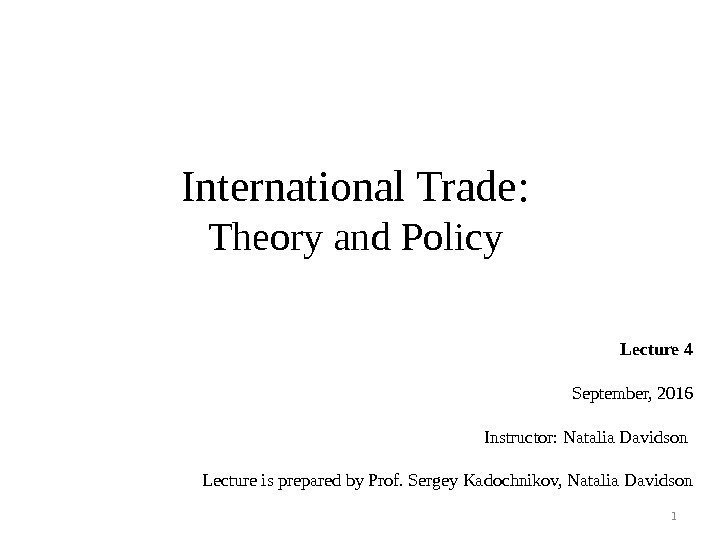
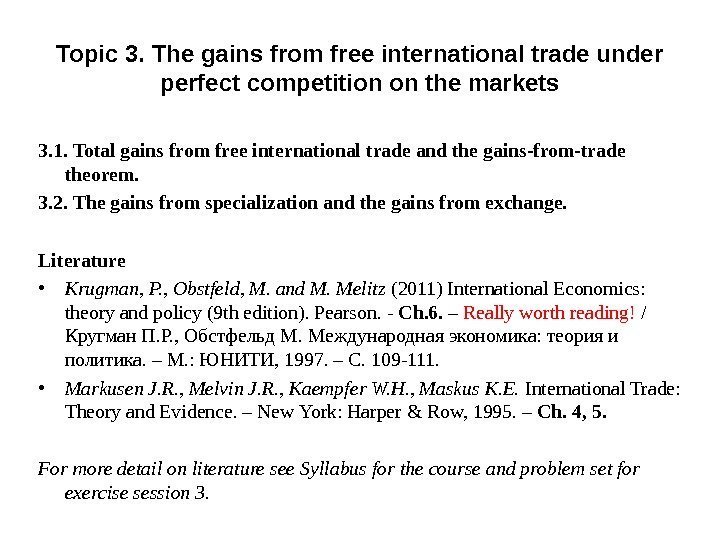
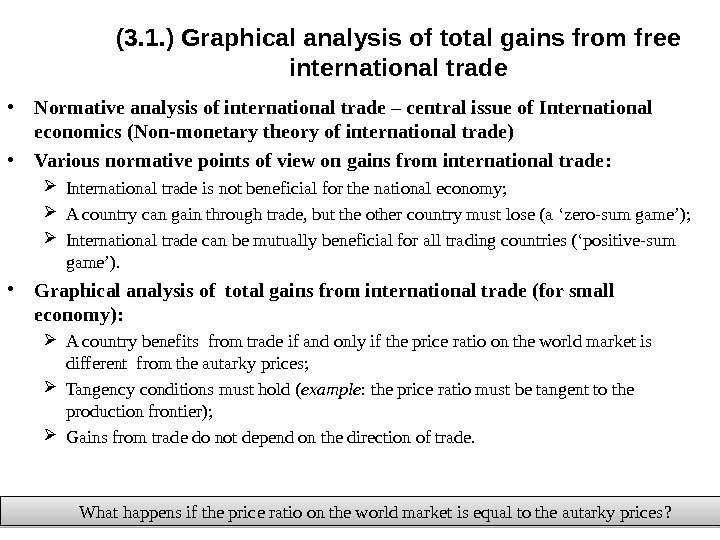
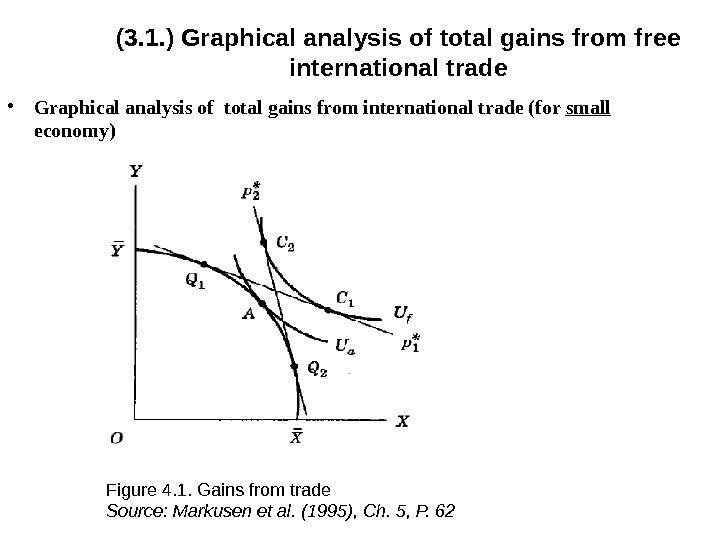
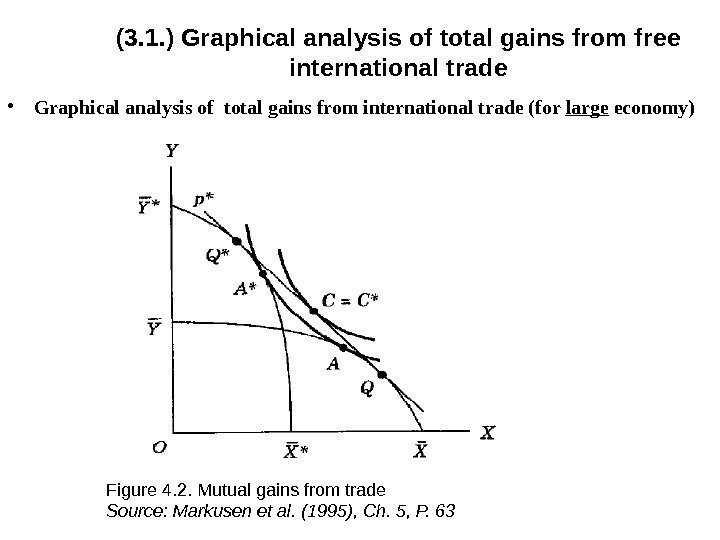
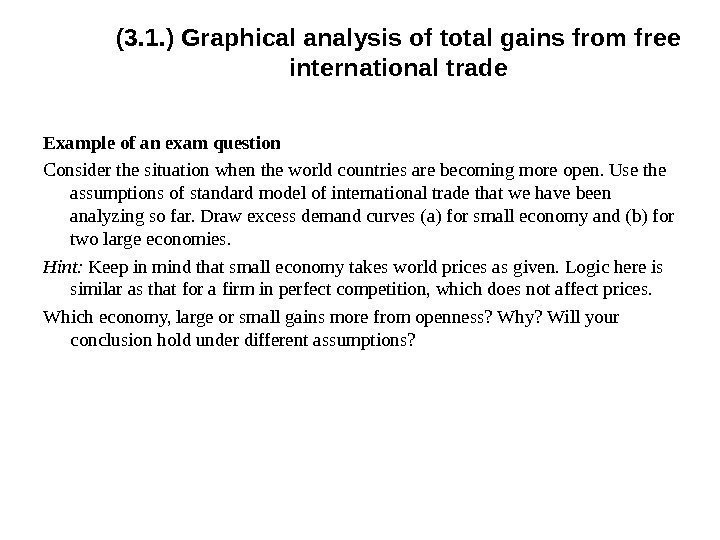
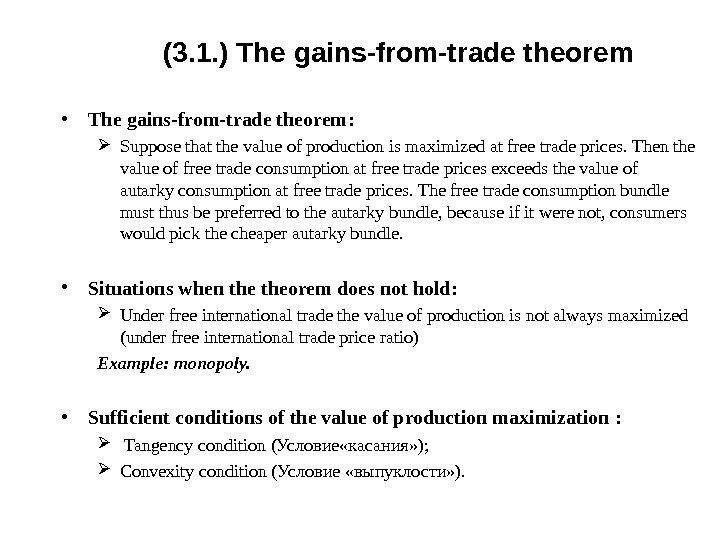
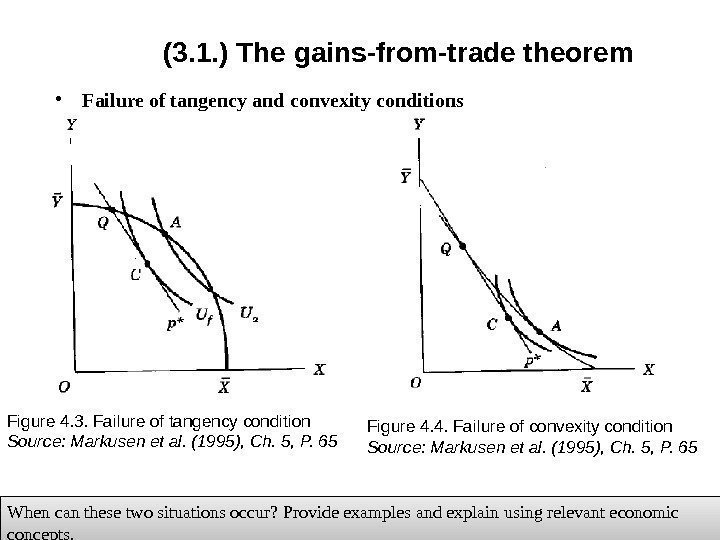
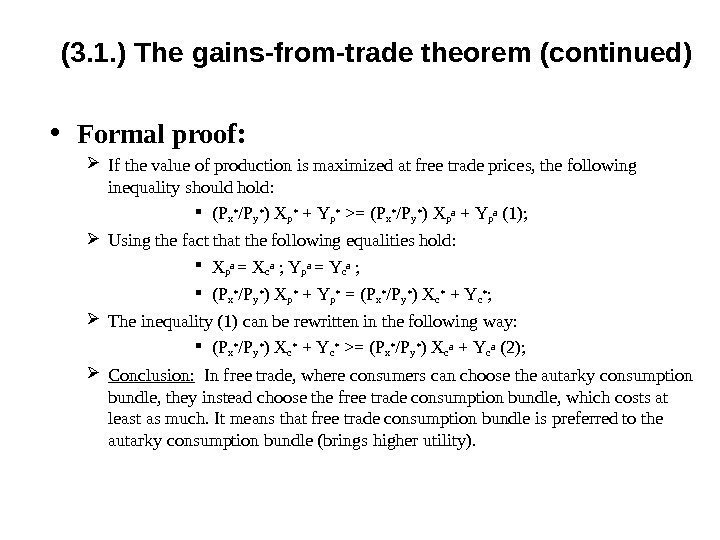
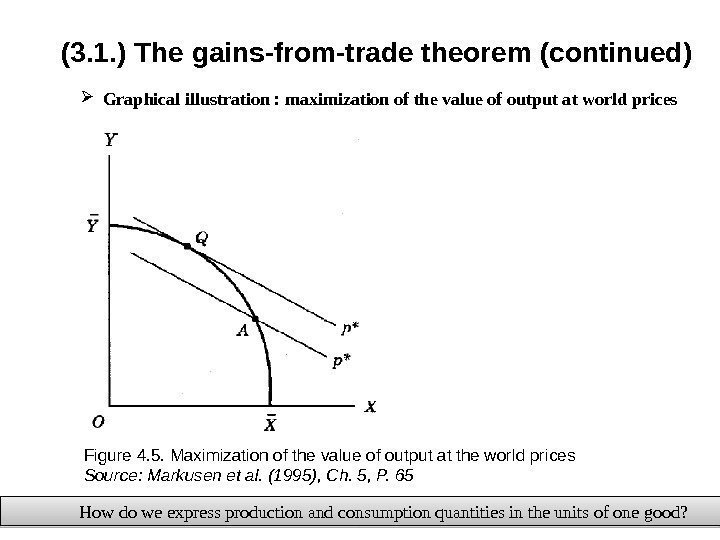
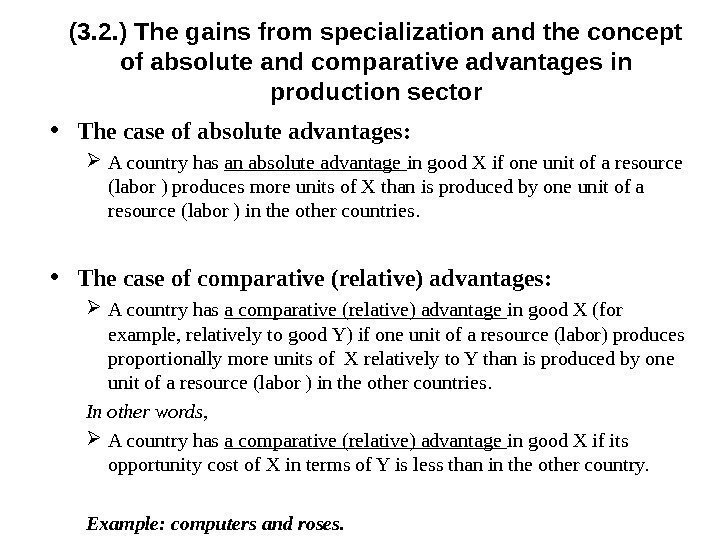
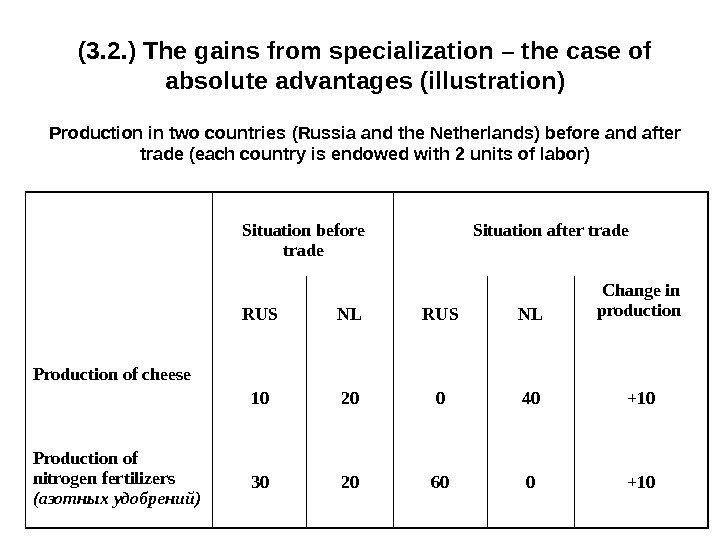
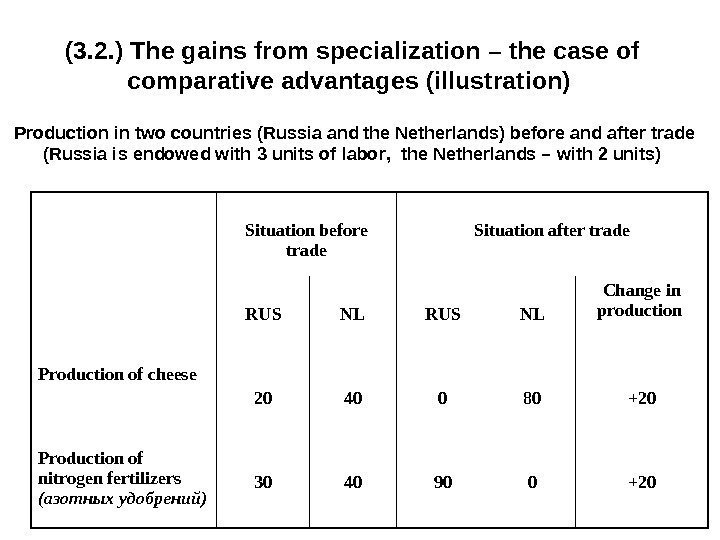
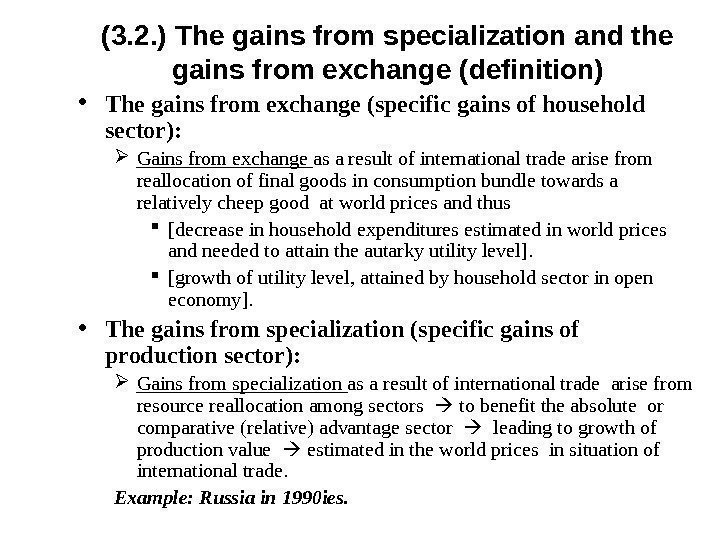
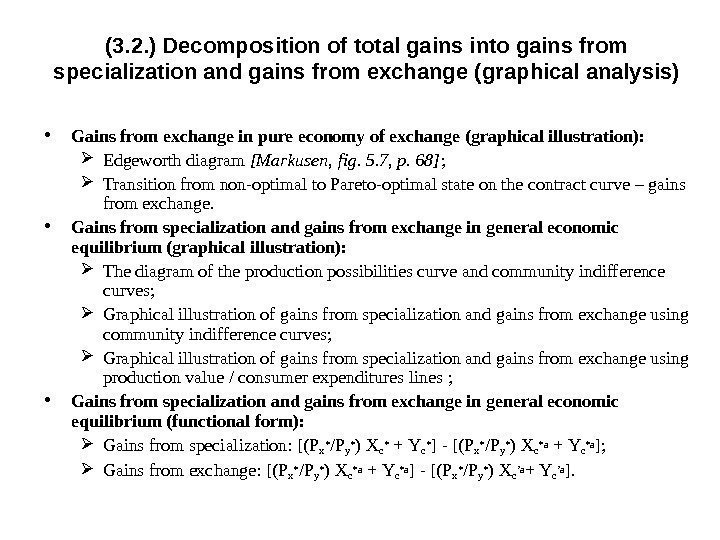
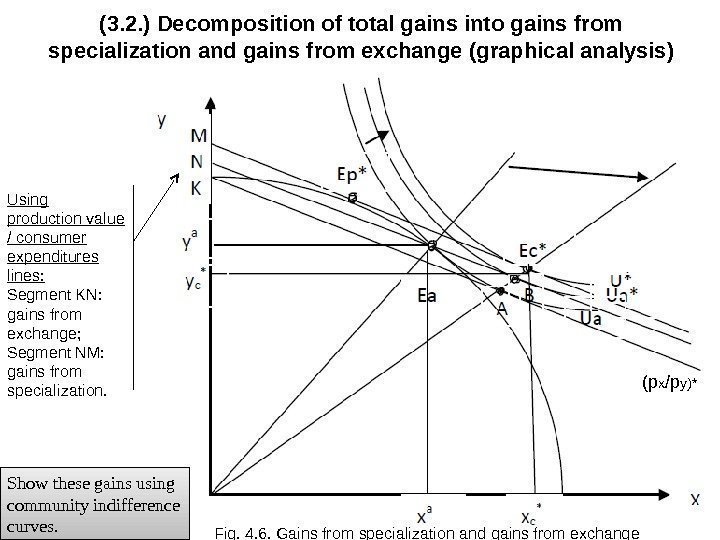
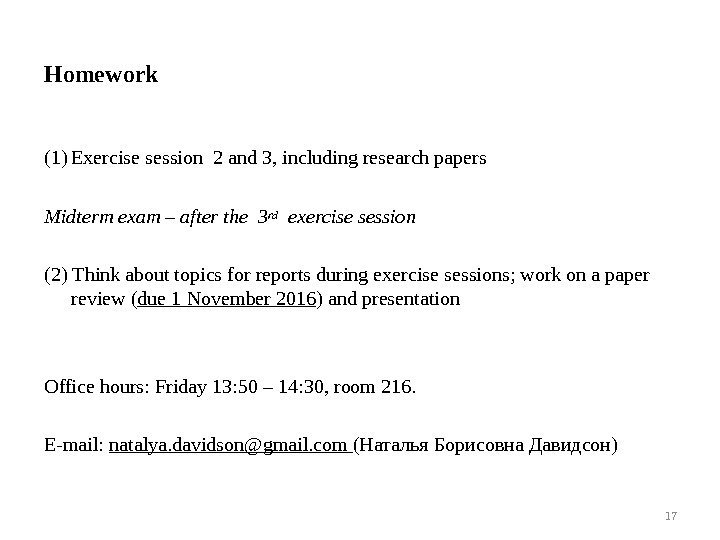
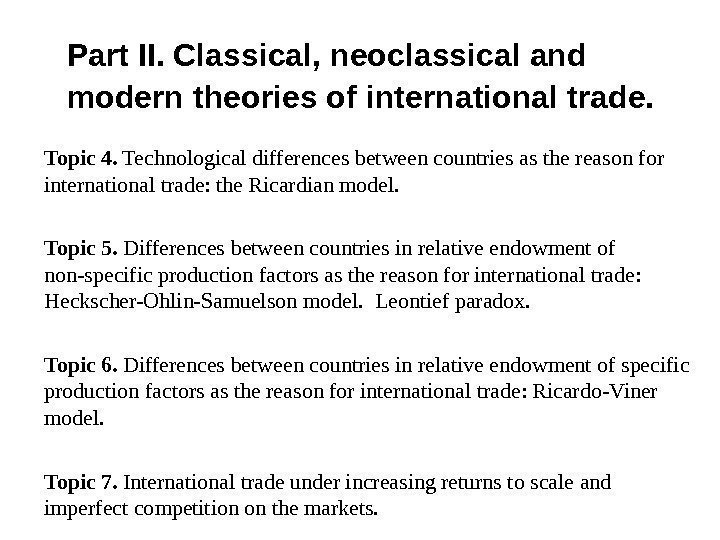
itt-autumn-2016-lecture-4-e.ppt
- Размер: 384.0 Кб
- Автор:
- Количество слайдов: 18
Описание презентации International Trade : Theory and Policy Lecture 4 по слайдам
 International Trade : Theory and Policy Lecture 4 September, 2016 Instructor: Natalia Davidson Lecture is prepared by Prof. Sergey Kadochnikov, Natalia Davidson
International Trade : Theory and Policy Lecture 4 September, 2016 Instructor: Natalia Davidson Lecture is prepared by Prof. Sergey Kadochnikov, Natalia Davidson
 Topic 3. The gains from free international trade under perfect competition on the markets 3. 1. Total gains from free international trade and the gains-from-trade theorem. 3. 2. The gains from specialization and the gains from exchange. Literature • Krugman, P. , Obstfeld, M. and M. Melitz (2011) International Economics: theory and policy (9 th edition). Pearson. — Ch. 6. – Really worth reading! / Кругман П. Р. , Обстфельд М. Международная экономика: теория и политика. – М. : ЮНИТИ, 1997. – С. 109 -111. • Markusen J. R. , Melvin J. R. , Kaempfer W. H. , Maskus K. E. International Trade: Theory and Evidence. – New York: Harper & Row, 1995. – Ch. 4, 5. For more detail on literature see Syllabus for the course and problem set for exercise session 3.
Topic 3. The gains from free international trade under perfect competition on the markets 3. 1. Total gains from free international trade and the gains-from-trade theorem. 3. 2. The gains from specialization and the gains from exchange. Literature • Krugman, P. , Obstfeld, M. and M. Melitz (2011) International Economics: theory and policy (9 th edition). Pearson. — Ch. 6. – Really worth reading! / Кругман П. Р. , Обстфельд М. Международная экономика: теория и политика. – М. : ЮНИТИ, 1997. – С. 109 -111. • Markusen J. R. , Melvin J. R. , Kaempfer W. H. , Maskus K. E. International Trade: Theory and Evidence. – New York: Harper & Row, 1995. – Ch. 4, 5. For more detail on literature see Syllabus for the course and problem set for exercise session 3.
 (3. 1. ) Graphical analysis of total gains from free international trade • Normative analysis of international trade – central issue of International economics (Non-monetary theory of international trade) • Various normative points of view on gains from international trade : International trade is not beneficial for the national economy; A country can gain through trade, but the other country must lose (a ‘zero-sum game’); International trade can be mutually beneficial for all trading countries (‘positive-sum game’). • Graphical analysis of total gains from international trade (for small economy) : A country benefits from trade if and only if the price ratio on the world market is different from the autarky prices; Tangency conditions must hold ( example : the price ratio must be tangent to the production frontier); Gains from trade do not depend on the direction of trade. What happens if the price ratio on the world market is equal to the autarky prices ?
(3. 1. ) Graphical analysis of total gains from free international trade • Normative analysis of international trade – central issue of International economics (Non-monetary theory of international trade) • Various normative points of view on gains from international trade : International trade is not beneficial for the national economy; A country can gain through trade, but the other country must lose (a ‘zero-sum game’); International trade can be mutually beneficial for all trading countries (‘positive-sum game’). • Graphical analysis of total gains from international trade (for small economy) : A country benefits from trade if and only if the price ratio on the world market is different from the autarky prices; Tangency conditions must hold ( example : the price ratio must be tangent to the production frontier); Gains from trade do not depend on the direction of trade. What happens if the price ratio on the world market is equal to the autarky prices ?
 (3. 1. ) Graphical analysis of total gains from free international trade • Graphical analysis of total gains from international trade (for small economy) Figure 4. 1. Gains from trade Source : Markusen et al. (1995), Ch. 5, P.
(3. 1. ) Graphical analysis of total gains from free international trade • Graphical analysis of total gains from international trade (for small economy) Figure 4. 1. Gains from trade Source : Markusen et al. (1995), Ch. 5, P.
 (3. 1. ) Graphical analysis of total gains from free international trade • Graphical analysis of total gains from international trade (for large economy) Figure 4. 2. Mutual gains from trade Source : Markusen et al. (1995), Ch. 5, P.
(3. 1. ) Graphical analysis of total gains from free international trade • Graphical analysis of total gains from international trade (for large economy) Figure 4. 2. Mutual gains from trade Source : Markusen et al. (1995), Ch. 5, P.
 Example of an exam question Consider the situation when the world countries are becoming more open. Use the assumptions of standard model of international trade that we have been analyzing so far. Draw excess demand curves (a) for small economy and (b) for two large economies. Hint: Keep in mind that small economy takes world prices as given. Logic here is similar as that for a firm in perfect competition, which does not affect prices. Which economy, large or small gains more from openness? Why? Will your conclusion hold under different assumptions? (3. 1. ) Graphical analysis of total gains from free international trade
Example of an exam question Consider the situation when the world countries are becoming more open. Use the assumptions of standard model of international trade that we have been analyzing so far. Draw excess demand curves (a) for small economy and (b) for two large economies. Hint: Keep in mind that small economy takes world prices as given. Logic here is similar as that for a firm in perfect competition, which does not affect prices. Which economy, large or small gains more from openness? Why? Will your conclusion hold under different assumptions? (3. 1. ) Graphical analysis of total gains from free international trade
 (3. 1. ) The gains-from-trade theorem • The gains-from-trade theorem : Suppose that the value of production is maximized at free trade prices. Then the value of free trade consumption at free trade prices exceeds the value of autarky consumption at free trade prices. The free trade consumption bundle must thus be preferred to the autarky bundle, because if it were not, consumers would pick the cheaper autarky bundle. • Situations when theorem does not hold : Under free international trade the value of production is not always maximized (under free international trade price ratio) Example: monopoly. • Sufficient conditions of the value of production maximization : Tangency condition (Условие «касания» ); Convexity condition (Условие «выпуклости» ).
(3. 1. ) The gains-from-trade theorem • The gains-from-trade theorem : Suppose that the value of production is maximized at free trade prices. Then the value of free trade consumption at free trade prices exceeds the value of autarky consumption at free trade prices. The free trade consumption bundle must thus be preferred to the autarky bundle, because if it were not, consumers would pick the cheaper autarky bundle. • Situations when theorem does not hold : Under free international trade the value of production is not always maximized (under free international trade price ratio) Example: monopoly. • Sufficient conditions of the value of production maximization : Tangency condition (Условие «касания» ); Convexity condition (Условие «выпуклости» ).
 (3. 1. ) The gains-from-trade theorem • Failure of tangency and convexity conditions Figure 4. 3. Failure of tangency condition Source : Markusen et al. (1995), Ch. 5, P. 65 Figure 4. 4. Failure of convexity condition Source : Markusen et al. (1995), Ch. 5, P. 65 When can these two situations occur? Provide examples and explain using relevant economic concepts.
(3. 1. ) The gains-from-trade theorem • Failure of tangency and convexity conditions Figure 4. 3. Failure of tangency condition Source : Markusen et al. (1995), Ch. 5, P. 65 Figure 4. 4. Failure of convexity condition Source : Markusen et al. (1995), Ch. 5, P. 65 When can these two situations occur? Provide examples and explain using relevant economic concepts.
 (3. 1. ) The gains-from-trade theorem ( continued ) • Formal proof : If the value of production is maximized at free trade prices, the following inequality should hold : ( Px* / Py* ) Xp* + Yp* > = ( Px* / Py* ) Xpа + Ypа (1); Using the fact that the following equalities hold : X pа = Xса ; Ypа = Yса ; ( P x* / Py* ) Xp* + Yp* = ( Px* / Py* ) Xc* + Yc* ; The inequality (1) can be rewritten in the following way : ( P x* / Py* ) Xс* + Yс* > = ( Px* / Py* ) Xса + Yса ( 2 ); Conclusion : In free trade, where consumers can choose the autarky consumption bundle, they instead choose the free trade consumption bundle, which costs at least as much. It means that free trade consumption bundle is preferred to the autarky consumption bundle (brings higher utility).
(3. 1. ) The gains-from-trade theorem ( continued ) • Formal proof : If the value of production is maximized at free trade prices, the following inequality should hold : ( Px* / Py* ) Xp* + Yp* > = ( Px* / Py* ) Xpа + Ypа (1); Using the fact that the following equalities hold : X pа = Xса ; Ypа = Yса ; ( P x* / Py* ) Xp* + Yp* = ( Px* / Py* ) Xc* + Yc* ; The inequality (1) can be rewritten in the following way : ( P x* / Py* ) Xс* + Yс* > = ( Px* / Py* ) Xса + Yса ( 2 ); Conclusion : In free trade, where consumers can choose the autarky consumption bundle, they instead choose the free trade consumption bundle, which costs at least as much. It means that free trade consumption bundle is preferred to the autarky consumption bundle (brings higher utility).
 (3. 1. ) The gains-from-trade theorem ( continued ) Graphical illustration : maximization of the value of output at world prices How do we express production and consumption quantities in the units of one good? Figure 4. 5. Maximization of the value of output at the world prices Source : Markusen et al. (1995), Ch. 5, P.
(3. 1. ) The gains-from-trade theorem ( continued ) Graphical illustration : maximization of the value of output at world prices How do we express production and consumption quantities in the units of one good? Figure 4. 5. Maximization of the value of output at the world prices Source : Markusen et al. (1995), Ch. 5, P.
 (3. 2. ) The gains from specialization and the concept of absolute and comparative advantages in production sector • The case of absolute advantages : A country has an absolute advantage in good X if one unit of a resource (labor ) produces more units of X than is produced by one unit of a resource (labor ) in the other countries. • The case of comparative (relative) advantages : A country has a comparative (relative) advantage in good X (for example, relatively to good Y) if one unit of a resource (labor) produces proportionally more units of X relatively to Y than is produced by one unit of a resource (labor ) in the other countries. In other words, A country has a comparative (relative) advantage in good X if its opportunity cost of X in terms of Y is less than in the other country. Example: computers and roses.
(3. 2. ) The gains from specialization and the concept of absolute and comparative advantages in production sector • The case of absolute advantages : A country has an absolute advantage in good X if one unit of a resource (labor ) produces more units of X than is produced by one unit of a resource (labor ) in the other countries. • The case of comparative (relative) advantages : A country has a comparative (relative) advantage in good X (for example, relatively to good Y) if one unit of a resource (labor) produces proportionally more units of X relatively to Y than is produced by one unit of a resource (labor ) in the other countries. In other words, A country has a comparative (relative) advantage in good X if its opportunity cost of X in terms of Y is less than in the other country. Example: computers and roses.
 (3. 2. ) The gains from specialization – the case of absolute advantages ( illustration ) Production in two countries ( Russia and the Netherlands) before and after trade ( each country is endowed with 2 units of labor ) Situation before trade Situation after trade RUS NL Change in production Production of cheese 10 20 0 40 +10 Production of nitrogen fertilizers ( азотных удобрений ) 30 20 60 0 +
(3. 2. ) The gains from specialization – the case of absolute advantages ( illustration ) Production in two countries ( Russia and the Netherlands) before and after trade ( each country is endowed with 2 units of labor ) Situation before trade Situation after trade RUS NL Change in production Production of cheese 10 20 0 40 +10 Production of nitrogen fertilizers ( азотных удобрений ) 30 20 60 0 +
 (3. 2. ) The gains from specialization – the case of comparative advantages ( illustration ) Production in two countries ( Russia and the Netherlands) before and after trade ( Russia is endowed with 3 units of labor , the Netherlands – with 2 units) Situation before trade Situation after trade RUS NL Change in production Production of cheese 20 40 0 80 +20 Production of nitrogen fertilizers ( азотных удобрений ) 30 40 90 0 +
(3. 2. ) The gains from specialization – the case of comparative advantages ( illustration ) Production in two countries ( Russia and the Netherlands) before and after trade ( Russia is endowed with 3 units of labor , the Netherlands – with 2 units) Situation before trade Situation after trade RUS NL Change in production Production of cheese 20 40 0 80 +20 Production of nitrogen fertilizers ( азотных удобрений ) 30 40 90 0 +
 (3. 2. ) The gains from specialization and the gains from exchange ( definition ) • The gains from exchange ( specific gains of household sector ): Gains from exchange as a result of international trade arise from reallocation of final goods in consumption bundle towards a relatively cheep good at world prices and thus [ decrease in household expenditures estimated in world prices and needed to attain the autarky utility level ]. [ growth of utility level, attained by household sector in open economy ]. • The gains from specialization ( specific gains of production sector ): Gains from specialization as a result of international trade arise from resource reallocation among sectors to benefit the absolute or comparative (relative) advantage sector leading to growth of production value estimated in the world prices in situation of international trade. Example: Russia in 1990 ies.
(3. 2. ) The gains from specialization and the gains from exchange ( definition ) • The gains from exchange ( specific gains of household sector ): Gains from exchange as a result of international trade arise from reallocation of final goods in consumption bundle towards a relatively cheep good at world prices and thus [ decrease in household expenditures estimated in world prices and needed to attain the autarky utility level ]. [ growth of utility level, attained by household sector in open economy ]. • The gains from specialization ( specific gains of production sector ): Gains from specialization as a result of international trade arise from resource reallocation among sectors to benefit the absolute or comparative (relative) advantage sector leading to growth of production value estimated in the world prices in situation of international trade. Example: Russia in 1990 ies.
 (3. 2. ) Decomposition of total gains into gains from specialization and gains from exchange ( graphical analysis ) • Gains from exchange in pure economy of exchange ( graphical illustration ): Edgeworth diagram [Markusen, fig. 5. 7, p. 68] ; Transition from non-optimal to Pareto-optimal state on the contract curve – gains from exchange. • Gains from specialization and gains from exchange in general economic equilibrium ( graphical illustration ): The diagram of the production possibilities curve and community indifference curves; Graphical illustration of gains from specialization and gains from exchange using production value / consumer expenditures lines ; • Gains from specialization and gains from exchange in general economic equilibrium ( functional form ): Gains from specialization : [ ( Px* / Py* ) Xc* + Yc* ] — [ ( Px* / Py* ) Xc*а + Yc*а ] ; Gains from exchange : [ ( P x* / Py* ) Xc*а + Yc*а ] — [ ( Px* / Py* ) Xc’а + Yc’а ].
(3. 2. ) Decomposition of total gains into gains from specialization and gains from exchange ( graphical analysis ) • Gains from exchange in pure economy of exchange ( graphical illustration ): Edgeworth diagram [Markusen, fig. 5. 7, p. 68] ; Transition from non-optimal to Pareto-optimal state on the contract curve – gains from exchange. • Gains from specialization and gains from exchange in general economic equilibrium ( graphical illustration ): The diagram of the production possibilities curve and community indifference curves; Graphical illustration of gains from specialization and gains from exchange using production value / consumer expenditures lines ; • Gains from specialization and gains from exchange in general economic equilibrium ( functional form ): Gains from specialization : [ ( Px* / Py* ) Xc* + Yc* ] — [ ( Px* / Py* ) Xc*а + Yc*а ] ; Gains from exchange : [ ( P x* / Py* ) Xc*а + Yc*а ] — [ ( Px* / Py* ) Xc’а + Yc’а ].
 (3. 2. ) Decomposition of total gains into gains from specialization and gains from exchange ( graphical analysis ) Using production value / consumer expenditures lines: Segment KN: gains from exchange; Segment NM: gains from specialization. Show these gains using community indifference curves. Fig. 4. 6. Gains from specialization and gains from exchange (p x /p y)*
(3. 2. ) Decomposition of total gains into gains from specialization and gains from exchange ( graphical analysis ) Using production value / consumer expenditures lines: Segment KN: gains from exchange; Segment NM: gains from specialization. Show these gains using community indifference curves. Fig. 4. 6. Gains from specialization and gains from exchange (p x /p y)*
 (1) Exercise session 2 and 3, including research papers Midterm exam – after the 3 rd exercise session (2) Think about topics for reports during exercise sessions; work on a paper review ( due 1 November 2016 ) and presentation Office hours: Friday 13: 50 – 14: 30, room 216. E-mail: natalya. davidson@gmail. com (Наталья Борисовна Давидсон) 17 Homework
(1) Exercise session 2 and 3, including research papers Midterm exam – after the 3 rd exercise session (2) Think about topics for reports during exercise sessions; work on a paper review ( due 1 November 2016 ) and presentation Office hours: Friday 13: 50 – 14: 30, room 216. E-mail: natalya. davidson@gmail. com (Наталья Борисовна Давидсон) 17 Homework
 Part II. Classical, neoclassical and modern theories of international trade. Topic 4. Technological differences between countries as the reason for international trade: the Ricardian model. Topic 5. Differences between countries in relative endowment of non-specific production factors as the reason for international trade: Heckscher-Ohlin-Samuelson model. Leontief paradox. Topic 6. Differences between countries in relative endowment of specific production factors as the reason for international trade: Ricardo-Viner model. Topic 7. International trade under increasing returns to scale and imperfect competition on the markets.
Part II. Classical, neoclassical and modern theories of international trade. Topic 4. Technological differences between countries as the reason for international trade: the Ricardian model. Topic 5. Differences between countries in relative endowment of non-specific production factors as the reason for international trade: Heckscher-Ohlin-Samuelson model. Leontief paradox. Topic 6. Differences between countries in relative endowment of specific production factors as the reason for international trade: Ricardo-Viner model. Topic 7. International trade under increasing returns to scale and imperfect competition on the markets.

